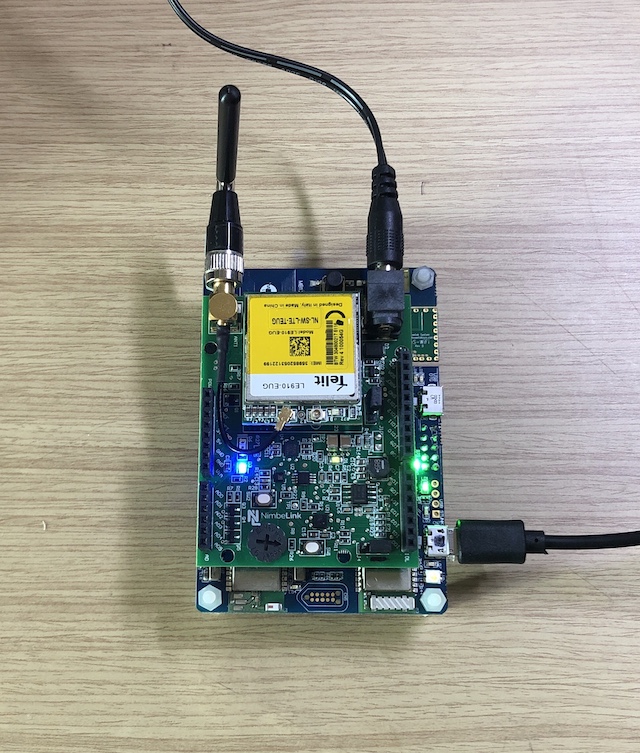This is an example based on mbed-os cellular APIs that demonstrates a TCP or UDP echo transaction with a public echo server.
This code is forked from https://os.mbed.com/teams/mbed-os-examples/code/mbed-os-example-cellular/
This is an example showing how to use Skywire board with LE910-x module.
In this example, I had used the LE910-EUG module for 4G communication. Mbed OS code wasn't changed for LE910-x, because the Telit' HE910 is included mainline code on Mbed OS already. HE910 and LE910 are most similar. Therefore you can use LE910 via HE910 driver. Please check to configure of mbed_app.json, and initialize code for Skywire board of main.cpp.
Open mbed_app.json, you need to define a UART for the MCU to communicate with the xE910 module.
"TELIT_HE910.tx" : "D1",
"TELIT_HE910.rx" : "D0",
"TELIT_HE910.provide-default" : true
If you are using Pelion CM, make the following settings:
"nsapi.default-cellular-apn" : "\"stream.co.uk\"",
"nsapi.default-cellular-username": "\"streamip\"",
"nsapi.default-cellular-password": "\"streamip\"",
For your information, please see Pelion Connectivity Quick start guide.

You can find Skywire sensor shield information though NimbeLink site.
Tested with
- DISCO_L475VG_IOT01A
- K64F
1. Import the application into your desktop:
mbed import https://os.mbed.com/users/Daniel_Lee/code/mbed-os-example-cellular-le910/ cd mbed-os-example-cellular-le910
2. Compile and program:
mbed compile -t GCC_ARM -m DISCO_L475VG_IOT01A
(supported toolchains : GCC_ARM / ARM / IAR)
3. Download binary to a target board
4. Result
mbed-os-example-cellular Built: Feb 7 2020, 07:02:27 Starting Skywire board with LE910-EUG Demo... Waiting for Skywire to Boot... Wait 15 seconds.. Establishing connection Connection Established. TCP: connected with echo.mbedcloudtesting.com server TCP: Sent 4 Bytes to echo.mbedcloudtesting.com Received from echo server 4 Bytes Success. Exiting
Diff: README.md
- Revision:
- 46:b872be3e1526
- Parent:
- 45:fcbbda26336a
--- a/README.md Fri Sep 20 12:01:53 2019 +0100
+++ b/README.md Mon Sep 23 09:01:53 2019 +0100
@@ -28,14 +28,12 @@
### Change the network and SIM credentials
-See the file `mbed_app.json` in the root directory of your application. This file contains all the user specific configurations your application needs. Provide the pin code for your SIM card, as well as any APN settings if needed. For example:
+See the file `mbed_app.json` in the root directory of your application. This file contains all the user specific configurations your application needs. Provide the pin code for your SIM card, as well as any other cellular settings, or `null` if not used. For example:
```json
- "nsapi.default-cellular-plmn": 0,
- "nsapi.default-cellular-sim-pin": "\"1234\"",
- "nsapi.default-cellular-apn": 0,
- "nsapi.default-cellular-username": 0,
- "nsapi.default-cellular-password": 0
+ "target_overrides": {
+ "*": {
+ "nsapi.default-cellular-sim-pin": "\"1234\"",
```
### Selecting socket type (TCP, UDP or NONIP)
@@ -85,6 +83,14 @@
[u-blox C027](https://os.mbed.com/platforms/u-blox-C027/)
[MultiTech MTS Dragonfly](https://os.mbed.com/platforms/MTS-Dragonfly/)
+For a cellular shield, you need to define which shield to use with `provide-default`, and also how the shield is connected to the Mbed OS board. For example, a generic AT/PPP modem would add from the `GENERIC_AT3GPP/mbed_lib.json` file to your `mbed_app.json`:
+```
+ "target_overrides": {
+ "GENERIC_AT3GPP.provide-default": true,
+ "GENERIC_AT3GPP.tx": "<tx-pinmap>",
+ "GENERIC_AT3GPP.rx": "<rx-pinmap>"
+ }
+```
## Compiling the application
@@ -132,7 +138,9 @@
* Make sure the fields `nsapi.default-cellular-sim-pin`, `nsapi.default-cellular-plmn`, `nsapi.default-cellular-apn`, `nsapi.default-cellular-username` and `nsapi.default-cellular-password` from the `mbed_app.json` file are filled in correctly. The correct values should appear in the user manual of the board if using eSIM or in the details of the SIM card if using normal SIM.
* Enable trace flag to have access to debug information `"mbed-trace.enable": true` and `"cellular.debug-at": true`.
-* Check that a default modem is defined, e.g. `"GENERIC_AT3GPP.provide-default": true`, `"GENERIC_AT3GPP.tx": "<tx-pinmap>"`, ...
+* Error Message: Assertion failed: iface usually means that a default modem is not defined, e.g. `"GENERIC_AT3GPP.provide-default": true`
+* If the modem does not respond to (AT) queries, check that UART pins (tx, rx, rts, cts) are connected and defined, e.g. `"GENERIC_AT3GPP.tx": "<tx-pinmap>"`, ...
+* It is a common case that a modem seems to connect fine with just USB power, but actually it needs to have an external power supply for a data connection.
* Try both `TCP` and `UDP` socket types.
* Try both `"lwip.ppp-enabled": true` and `"lwip.ppp-enabled": false`.
* The modem may support only a fixed baud-rate, such as `"platform.default-serial-baud-rate": 9600`.
 Daniel Lee
Daniel Lee